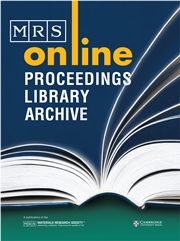Article contents
Synergy between Chemical Dissolution and Mechanical Abrasion during Chemical Mechanical Polishing of Copper
Published online by Cambridge University Press: 01 February 2011
Abstract
The synergistic roles of chemical dissolution and mechanical abrasion on the material removal mechanism during CMP process are explored. A set of nano-wear experiments are conducted on electro-plated copper surfaces with systematic exposure to active slurries. Initial results of in situ wear test in chemically active slurry showed an increased material removal rate (MRR) relative to a dry wear test. To understand the synergistic effects of chemical dissolution and mechanical abrasion, we have investigated two plausible mechanisms of material removal. Mechanism-I is based on chemical dissolution enhanced mechanical abrasion. A soft layer of chemical products is assumed to be formed on top of the polished surface due to chemical reaction with a rate much faster than the mechanical abrasion rate. It is then followed by a gentle mechanical abrasion of that soft layer. An increase in the MRR of up to 100% is identified based on the etching time and the down force. Mechanism-II is based on mechanical abrasion accelerated chemical etching. In this case, the nano-wear experiments are first performed to generate local variation of the residual stress levels, and then followed by chemical etching to investigate the variation of the wear depth and the evolution of surface topography due to etching. It is found that the residual stress caused by the mechanical wear enhances the chemical etching rate, as manifested by the increase of wear depth. The developed understanding from these experiments can be used in future studies to control the rates of chemical dissolution and mechanical abrasion as well as investigating the various process-induced defects.
Information
- Type
- Research Article
- Information
- Copyright
- Copyright © Materials Research Society 2005
References
- 2
- Cited by

